
Occupational Silica Inhalation Regulations Under Fire
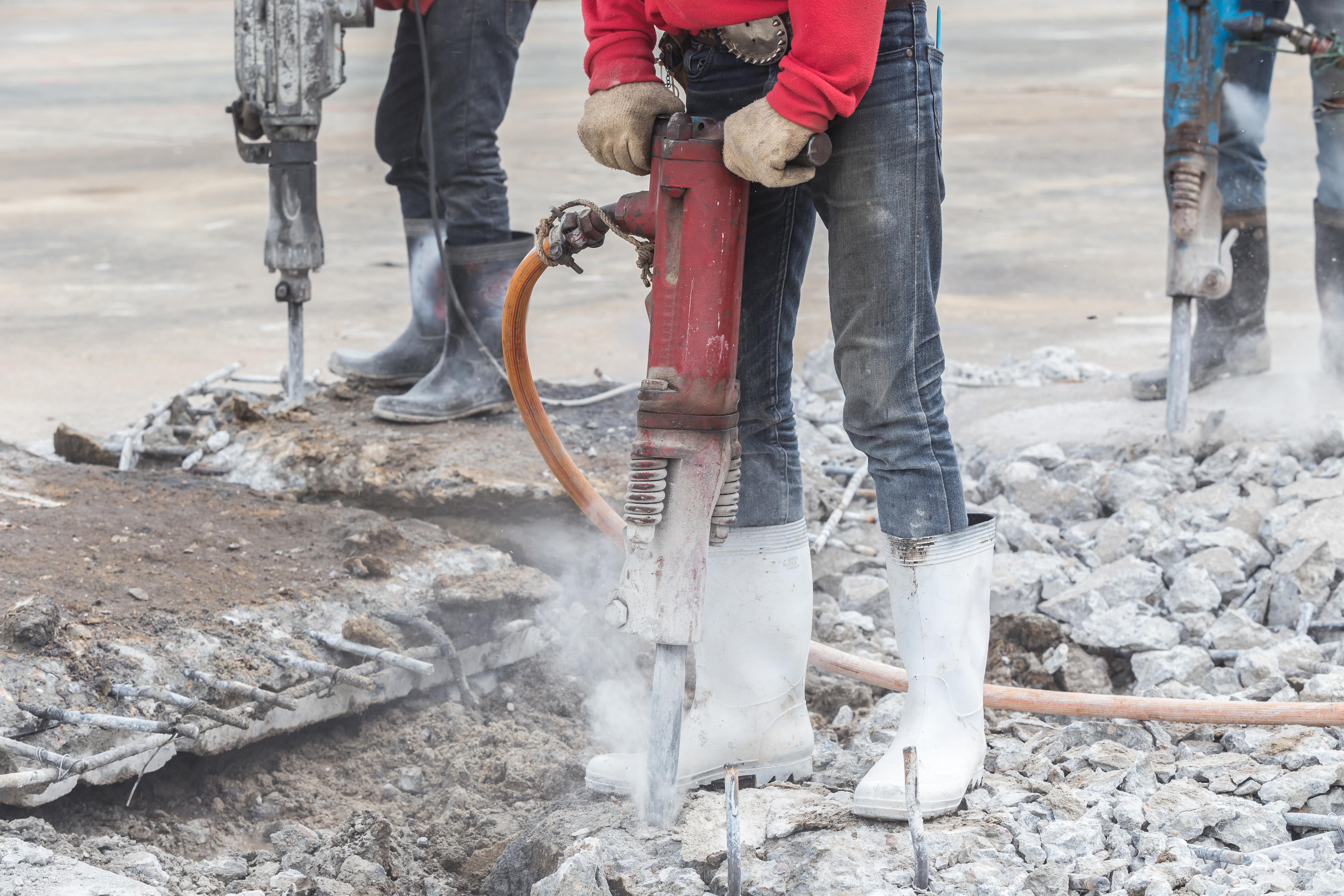
Written by: Virginia McCormick, NES, Inc.
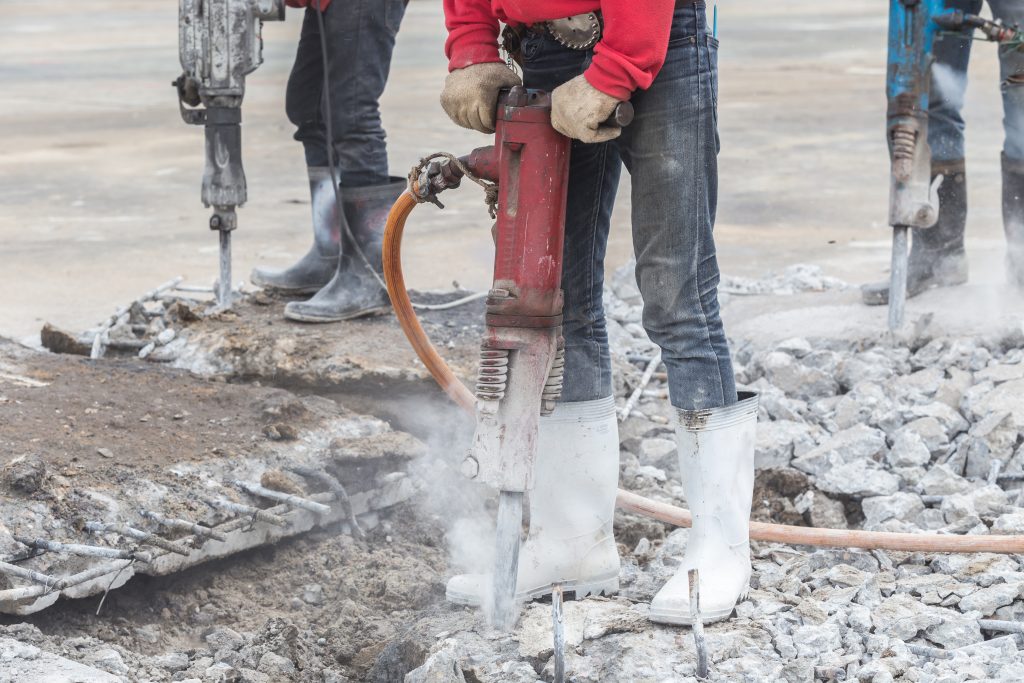
A case report regarding silica-related diseases in the engineered stone fabrication industry has prompted lawmakers to review inhalation standards.
Regulators Seek Review of Occupational Silica Inhalation Following Case Report
In October 2019, the U.S. House Committee of Education and Labor issued a letter to the Department of Labor regarding the protection of engineered stone fabrication workers. The letter urged the Department’s Occupational Safety and Health Administration (OSHA) agency to, “strengthen monitoring and protections for engineered stone fabrication workers at high risk of silicosis and other silica-related diseases.”
The letter was prompted by a September 2019 report issued by the Centers for Disease Control and Prevention (CDC) that detailed 18 cases of silicosis across four states (California, Colorado, Texas, and Washington). The cases included two fatalities and several reports of autoimmune disease and tuberculosis infection, and all cases reported concerned stone fabrication workers.
In the House Committee’s letter, Chairman Robert Scott and Chairwoman Alma Adams refer to the CDC report as potentially identifying, “the tip of the iceberg among the 8,694 establishments and 96,366 employees in the stone fabrication industry.”
The letter ultimately called upon OSHA to issue a new National Emphasis Program (NEP) that focuses on engineered stone fabrication establishments. The implication is that, without an active NEP, it is more difficult for OSHA to enter a workplace without a specific complaint, injury, or referral, which may lead to more incidents of silicosis. The letter also suggested that OSHA work with the CDC and other state health departments to improve public health surveillance for silica-related disease and occupational silica inhalation.
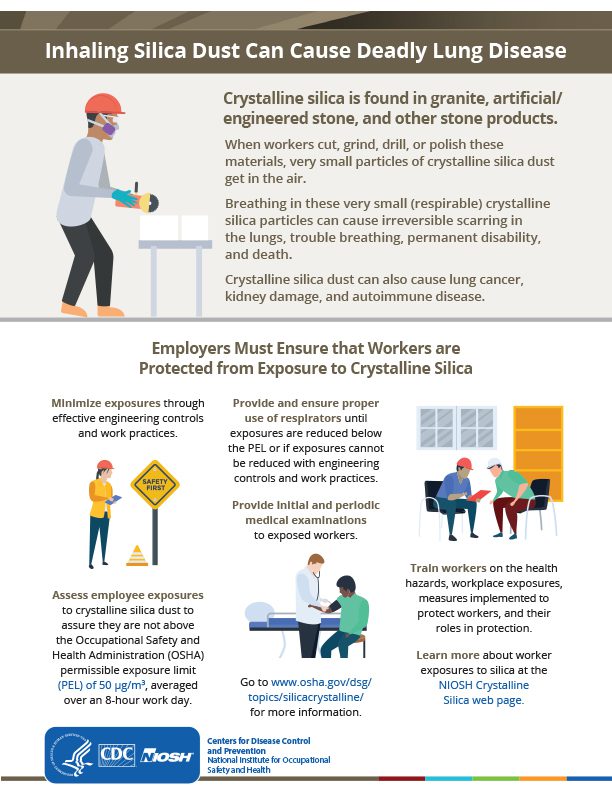
The CDC identifies disease surveillance and regulatory enforcement as crucial methods to addressing the silicosis threat in the stone fabrication industry. (Infographic Source: CDC Inhaling Silica Dust Can Cause Deadly Lung Disease)
The 2016 OSHA Silica Standard
In March of 2016, OSHA published a final rule regarding occupational silica inhalation in general industry. Under 29 CFR 1910.1053, employers are required to adhere to certain practices in order to protect their employees and limit occupational silica inhalation. Employers must:
- Measure the amount of silica workers are exposed to if above the action level of 25 μg/m³ (micrograms of silica per cubic meter of air)
- Ensure silica exposure remains at or below the permissible exposure limit (PEL) of 50 μg/m³, or provide respirators when the PEL cannot be maintained
- Establish and implement a written Exposure Control Plan that describes both workplace tasks that may lead to silica exposure as well as the methods used to limit that exposure for each task
- Ensure that the employer’s Exposure Control Plan accounts for housekeeping methods used to limit exposure
- Provide no-cost medical surveillance every three years to any employee potentially exposed to occupational silica inhalation hazards
- Include respirable crystalline silica in their hazard communication programs, which must at minimum address cancer, lung effects, immune system effects, and kidney effects
However, the 2016 standard has been criticized in recent years. According to some critics, small-scale stone fabrication shops may face unique challenges not covered by the standard, such as limited awareness, expertise, and investment in exposure-control technologies.
Additionally, many employees in the fabricated stone industry are immigrants. As noted by the CDC, immigrant workers are often more vulnerable to workplace hazards such as silica due to fewer employment options, diminished access to medical care, and fear of retaliation when reporting occupational hazards to regulatory agencies like OSHA.

The 2016 OSHA final rule regarding occupational silica inhalation identifies the requirements for employers, but some critics say the standard is not enough to effectively protect workers.
Engineered Stone Industry & Occupational Silica Inhalation: A Deadly Mix
According to the September 2019 CDC report, “stone fabrication workers, especially those working with engineered stone, are at risk for silicosis.” Silicosis is an occupational lung disease that is caused by breathing in silica dust. The disease is incurable, with symptoms worsening over time, often leading to major lung infections, disease, and death in otherwise healthy individuals. According to the National Institute for Occupational Safety and Health (NIOSH), more than 200 U.S. workers die each year due to this disease and hundreds more become disabled.
Crystalline silica, also known as quartz, is a common mineral found in soil, sand, granite, and rock. Quartz is composed of silicon and oxygen and is the primarily component in engineered stone. Due to this composition, engineered stone contains substantially more silica than does natural stone (> 90%, compared with < 45% in granite) and often produces a large amount of fine silica dust when cut, broken, crushed, or otherwise worked.
Quartz has become a very popular option for kitchen, bathroom, and retail spaces. And as noted by the CDC, quartz surface imports to the U.S. increased approximately 800% between 2010 and 2018. The material is popular mainly due to its durability, stain-resistant properties, simple maintenance, and customizable nature.
Although OSHA and many state agencies have been aware of silica inhalation hazards in the stone fabrication industry for many years, this awareness is often not conveyed to the workers. A 2014 NIOSH publication titled “Silicosis: Learn the Facts!” stated that chronic silicosis can often go undetected for 15 to 20 years after initial exposure. By this point, many uninformed workers will have permanent lung damage and are at increased risk of lung infections such as tuberculosis.
The House Committee maintains that the current OSHA standard no longer effectively protects workers from occupational silica inhalation hazards – especially those workers in the engineered stone industry.
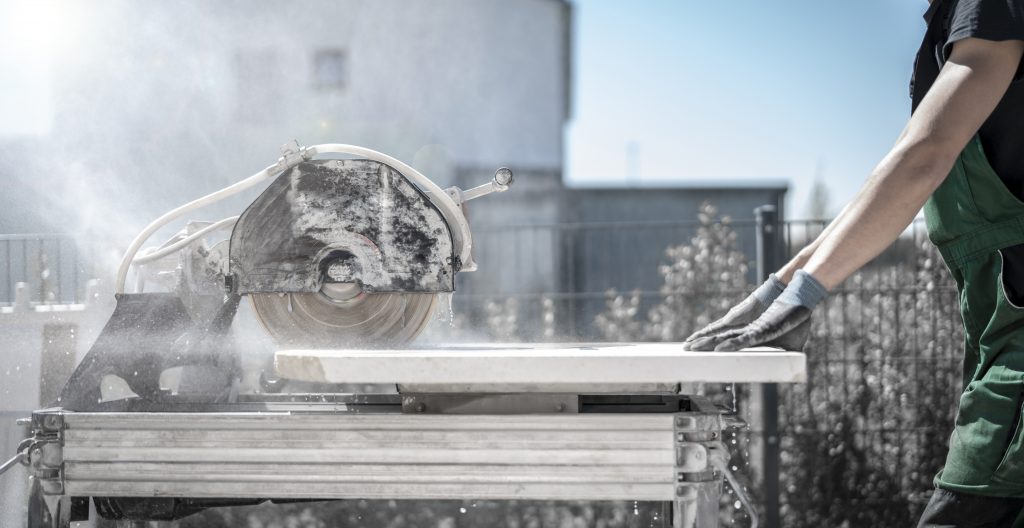
Quartz-based composite material, commonly used for countertops, can contain > 90% crystalline silica, according to the CDC.
Methods to Reduce Occupation Silica Inhalation
There are several methods currently recommended to reduce occupational silica inhalation. According to OSHA, the most common methods of limiting silica exposures are wet methods, where water is used to keep silica-containing dust from getting into the air, and vacuum dust collection systems, which capture dust at the point it is created. Both methods are examples of engineering controls, in which the worker is effectively isolated from the hazard. Other methods recommended by the CDC include:
- Eliminating job tasks with a risk of exposure
- Substituting out materials for those with smaller concentrations of silica
- Allocating less time spent working around silica dust
- Ensuring regular and proper use of personal protective equipment, such as respirators
Employers are always encouraged to seek elimination, substitution, engineering, or administrative controls when dealing with a workplace hazard such as occupational silica inhalation before resorting to the less effective method of personal protective equipment (PPE).
For more information on workplace hazard control methods, check out the April 2019 NES blog NIOSH’s Hierarchy of Controls.
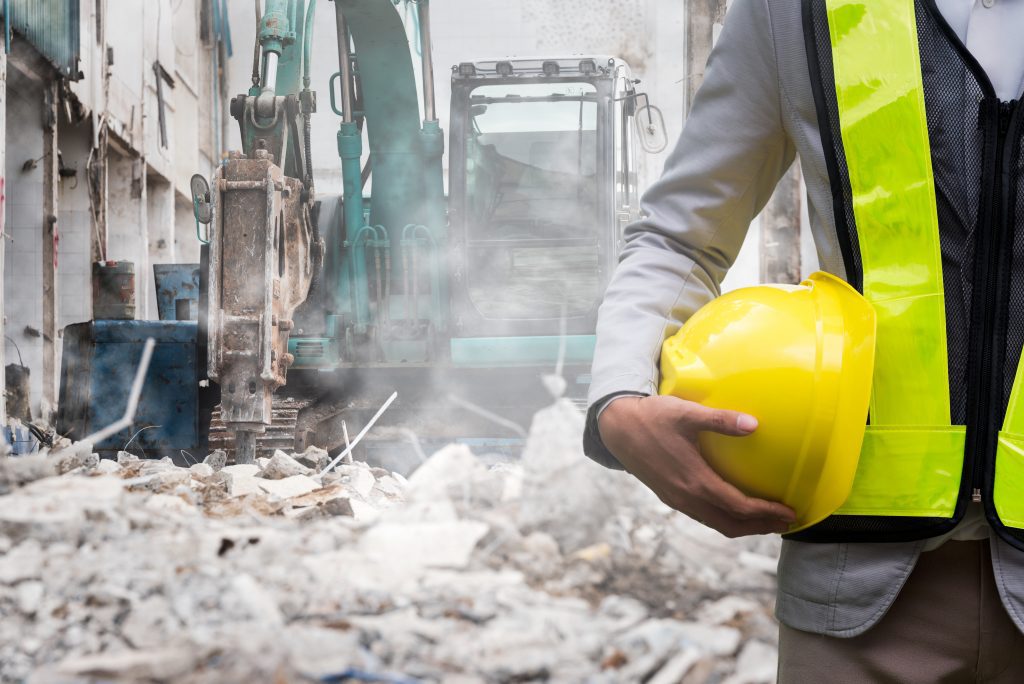
Many workers do not report occupational silica inhalation hazards due to fear of retaliation from employers. Some workers’ advocates suggest that a new NEP issued from OSHA may make it easier to identify these cases.
Remaining Dedicated to Protecting Employees from Occupational Exposure
Employers must comply with safety and health standards and regulations issued and enforced either by OSHA or by an OSHA-approved state plan. Additionally, the General Duty Clause requires employers to provide their employees with a workplace free from recognized hazards likely to cause death or serious physical harm.
At this point, neither the Department of Labor nor OSHA have responded to the letter sent by the House Committee or the CDC case report. The 2016 final rule remains the most current regulation regarding silica exposure for workers, with no industry-specifics regarding fabricated stonework.
Since 1968, more than 14,000 workers in the U.S. have died from silicosis, and approximately 2.3 million workers are exposed to silica in the workplace. And as the number of cases associated with silicosis continue to develop, due in large part to the increasing popularity of engineered stone, employers are reminded that the full scope of silica-related diseases has yet to be revealed.
In order to comply with OSHA and the General Duty Clause, employers must ensure they maintain current knowledge of the best ways to limit occupational silica inhalation. By implementing effective control methods, updating PPE, and regularly seeking industry-specific training, employers dedicate themselves to protecting vulnerable workers from life-threatening occupational silica inhalation.
NES can provide employees who will potentially be working around silica in the course of their job duties with training to heighten their awareness of the hazards presented by those workplace tasks. Training covers topics such as mandatory compliance regulations, inhalation hazards, methods of control, air monitoring, PPE, and toxicology. For more information on NES silica awareness training, please contact us at 916-353-2360 / 800-637-2384 or email us at office@nesglobal.net.
References:
Education & Labor Committee: Letter to Dept. of Labor
OSHA Fact Sheet: OSHA’s Proposed Crystalline Silica Rule: Construction
OSHA: Occupational Exposure to Respirable Crystalline Silica, 29 CFR 1910.1053 FAQs
Work Safely with Silica: Regulations & Requirements
Occupational Exposures and Health Outcomes Among Immigrants in the USA, Occupational Health
NIOSH: Silicosis: Learn the Facts!
NPR: Lawmakers Seek Protections For Workers Against Lung Damage Tied To Making Countertops
NPR: ‘It’s Going To Get Worse’: How U.S. Countertop Workers Started Getting Sick
